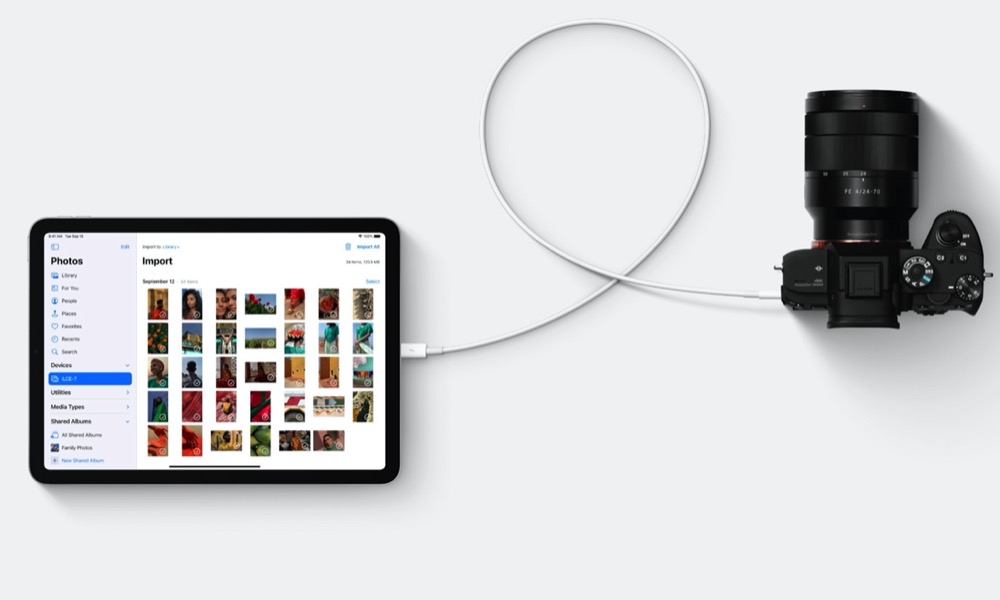The iPad Pro Is Getting a Thunderbolt Port (and It’s Coming Next Month)
 Credit: Apple
Credit: Apple
Toggle Dark Mode
Alongside the news this week that Apple won’t be holding a March event after all came reports that Apple’s upcoming mini-LED iPad Pro isn’t expected to launch until sometime in the second quarter of this year — meaning at least April. However, we’re also starting to get some more information on exactly what Apple plans to pack into its next high-end iPad model.
While we’ve been hearing about a mini-LED screen for some time, it’s been a bit less clear whether that was only going to come to the larger 12.9-inch version or whether the 11-inch iPad Pro would also be invited to the party. That’s still not entirely clear, but now Bloomberg’s Mark Gurman has some additional details on what else we can expect.
Right off the bat, Gurman notes that the new iPad Pro will feature “a better processor and improved cameras” — no surprise there — while also following the same style as the 2020 iPad Pro models.
He also reveals that Apple does in fact plan to release new versions of both the 12.9-inch and 11-inch models at the same time, even if only one of them gains the new mini-LED display.
However, Gurman also adds that the new chip will be “on par” with Apple’s M1 chip which debuted last fall in the new MacBook Air, MacBook Pro, and Mac mini.
Gurman doesn’t identify the chip by name, but the implication that it won’t actually be an M1 chip; Apple will likely keep its usual A-series naming, so names like “A14X” or “A14Z” seem to be the most likely designations.
Although some have speculated that Apple’s move to its own silicon would result in a unifying of chipsets between the Mac and iPad lineups, there’s no reason to believe that this is the case. The whole point of Apple custom-designing its own chips from scratch is that it can tailor them to the needs of each platform, and the Mac and iPad are still very different devices.
For example, the M1 chip that Apple uses in its Macs includes components that would arguably be pointless on an iPad, such as PCI Express and NVMe SSD storage controllers. There’s also a Thunderbolt / USB 4 controller backed into the M1, but this is where things get a bit more interesting.
A Thunderbolt iPad
According to Gurman, Apple has been testing a Thunderbolt connector on the new iPad Pro models, which would potentially enable a whole new world of connectivity for professional applications.
For example, although a Thunderbolt port looks the same as the current USB-C port, it provides a different interface that can achieve much faster throughput, and would allow the iPad Pro to embrace even more powerful external monitors, hard drives, and pro studio equipment.
Just like the Thunderbolt ports found on Apple’s Macs, the new port would naturally remain backward-compatible with USB-C, so all current peripherals would continue to work, including chargers.
Gurman does add that, as far as he knows, the new port has only been in testing, so it’s unclear if it will be included in the final production models. However, since Apple would likely follow the same chip design playbook as it did for the M1, it would need to include the Thunderbolt controller in what SoC it’s fabricating for the new iPad Pro.
With the device preparing to enter mass production, it seems likely that Apple will need to be already committed to this one way or the other.
What About the Other iPads?
At this point, however, it looks like a new iPad Pro is the only iPad update we’ll be seeing this spring. Gurman does mention the entry-level iPad and iPad mini as being in the works to be updated this year as well, although he’s hedging his bets on the smaller model, noting that Apple is preparing to launch the new iPad mini “as early as this year,” which implies that we won’t likely see it before the fall.
Reports of what Apple is up to with the smaller iPad have been all over the place in recent weeks, with conflicting reports suggesting that Apple could be considering two different approaches — or even releasing two versions of the iPad mini.
Reputable analyst Ming-Chi Kuo has been predicting since last year that the next-generation iPad mini would adopt the style that we’ve now seen in 2020 iPad Air — an edge-to-edge display with Touch ID embedded in the side button. However, a more recent report from Mac Otakara claims that the update will be considerably more modest, with Apple retaining the same design and simply pushing the screen size up a bit by narrowing the bezels.
This would be similar to what it did with the transition it made from a 9.7-inch to a 10.5-inch display on the iPad Pro back in 2017 — a move that’s since been adopted by all the traditional iPads.
[The information provided in this article has NOT been confirmed by Apple and may be speculation. Provided details may not be factual. Take all rumors, tech or otherwise, with a grain of salt.]






